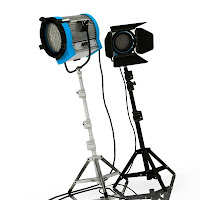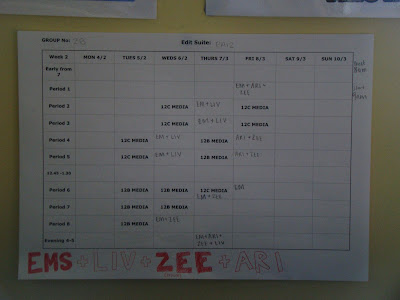In order to answer this
question clearly I will be splitting my answer up into sections: genre,
narrative structure, form and style.
Genre
Our chosen genre was ‘chick-flick’. We as a group decided on this genre as we are all familiar and passionate about it, having each watched many chick-flicks ourselves. Therefore we were keen to take this genre on and create our very own of its kind.
Here is a table showing some of the key conventions of the genre we found in our research, and how we either incorporated or challenged them in
our opening sequence:
Here is a table showing the conventions of opening sequences we learnt from our research, and how we have either followed these conventions or not-
From researching the narrative structures of chick flicks such as 'Wild Child' and 'St.Trinians', we found that many followed the structure of Todorov's narrative theory. Therefore we decided to apply this to our own film:
Equilibrium (our opening sequence)- Lauren and Scarlett go about their normal daily life and morning routine, getting ready for school.
 Disequilibrium/disruption- Scarlett arrives at school for the first time and purposely targets Lauren and strategically 'ruins' her life; making up lies to turn her friends against her, she flirts with her boyfriend and eventually steals him, and spills secrets to her parents to get her into trouble.
Disequilibrium/disruption- Scarlett arrives at school for the first time and purposely targets Lauren and strategically 'ruins' her life; making up lies to turn her friends against her, she flirts with her boyfriend and eventually steals him, and spills secrets to her parents to get her into trouble.
New Equilibrium/resolution- Lauren realises she is better off without her boyfriend, and Scarlett happily settles down with her new life. Both the girls make thier peace with each other, go off to university and never see each other again (possible flash forward).
As mentioned above, our opening sequence was the part of our film which represented the equilibrium state. Straight after this the disruption took place, quite early on the film like most other chick flicks such as Wild Child and St Trinian's for example. We used the narrative device of ellipsis, and a lot of cross-cutting to convey this as we did not want to bore our audience and felt all aspects of the characters morning was not vital to include.
Form and Style
- Here is a commentary video myself and my teammate Arianna made, in order to reflect upon some aspects of our opening sequence's style and form. We mainly discuss pace, editing techniques and mise-en-scene.
- We used an upbeat soundtrack to create a fun and girly mood for our sequence. I feel this was successful as many people commented on it during feedback, saying it 'fit the piece well' and was 'lively'. 'Full of Mesh' was the name of the track and it has no copyright so we were able to use it without asking permission (found on www.freeplaymusic.com).
- We used many CU's (light blue) and MS's (green) in our sequence to show specific objects and expressions, but not many LS's (dark blue). Perhaps our establishing shot could have been wider (maybe a VLS) to give our audience a better sense of location. We also could have widened other MS's such the girls walking into school and Scarlett leaving her house to create the same effect. We did however include other types of shots such as OTS's (turn on shower shot) and used high and low angle shots where appropriate.
- Looking back at our opening sequence I was worried there was not much that actually 'happened', our two girls merely got ready and arrived at school. However looking back at other opening sequences from our genre, most do not tell much of a story and have a similar narrative content to ours. For example the opening to 'Legally Blonde' (shown above) where a letter is received Therefore I feel our sequence serves its function and purpose and follows the correct format.
Overall I feel our opening sequence is quite conventional for its genre as a majority of it shows the typical 'getting ready in the morning routine', however we have broken a few conventions, the main one I feel being that of having two main female protagonists, instead of just one. No chick-flick we researched had two female protagonists.



















.jpg)
.jpg)



























